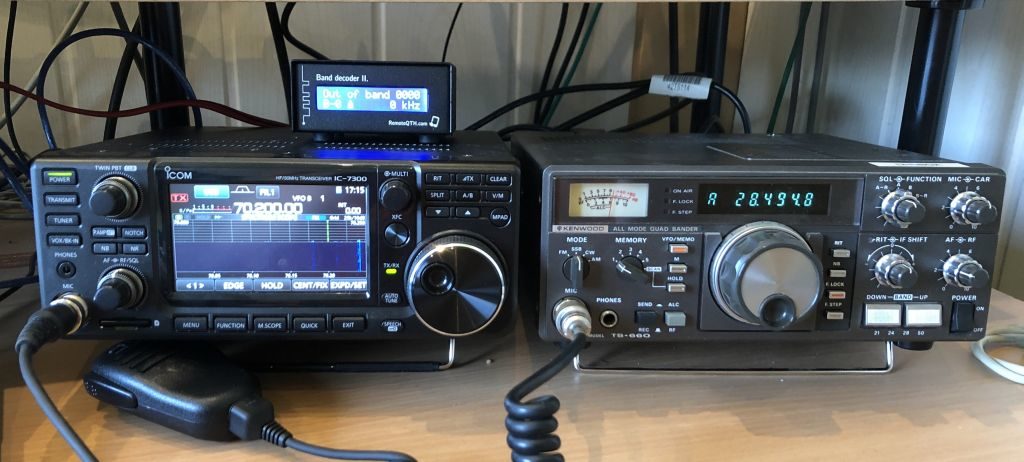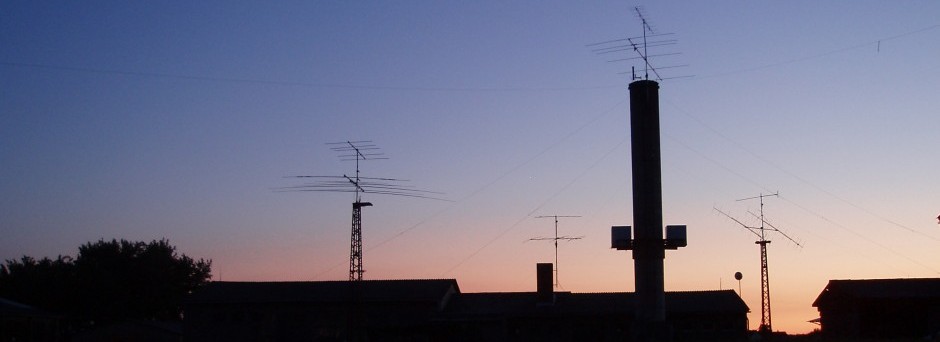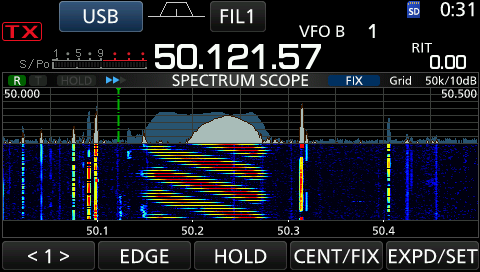Arrived at the station early this afternoon. Brought the IC-7300 along for WPX-CW this weekend as well as (hopefully!) some fun on 4 m during the next few days (a week of holidays next week). Second radio I took with me is my old Kenwood TS-660 which has been in storage for the last few years. It’s kind of a collection item, took me a few years to find one in good condition and finally bought it from someone in Italy around 2011/12 if memory serves me well. It’s one of the few “special” transceivers produced during the early 80ies that served the (back then) big market of Japanese Novice licensees with providing QRP power level (10 W) access to 15, 12, 10 & 6 m. There was a TS-670 (based on the TS-430) with 40, 15, 10 & 6 m, too, but I liked the design of the ‘660 (based on the TS-130) much better. I even used it with a small power amp for one or two seasons on 6 m and was quite satisfied. We also put it into temporary duty for the DB0UM/B beacon for a few month’ a few years ago. Now packing everything for our move of house it was about time to get it on the air once more. 😉

New and old: Left the Icom IC-7300 modern direct sampling SDR of 2018, right the Kenwood TS-660 discrete components transceiver of 1981. Exactly the same size, but 100 W on all bands from 160 to 4 m in the ‘7300 while only 10 W on 4 bands in the ‘660. Now quite some features missing but still very enjoyable!
It still works perfectly well. I made a few QSOs on all of it’s four bands this afternoon. And it still gets unsolicited good audio reports! Nevertheless I meanwhile prefer all the new technology and don’t want to miss the bandscope in the ‘7300 on 4 m anymore. It was a clear advantage this afternoon again seeing the SV beacons suddenly pop up as well as SV’s calling CQ on 70.200 as well as signals showing up on 70.154, the FT8 frequency. Nice to get a feeling for band conditions visually, too!
Speaking of 4 m we had a nice 1 hour opening today providing 2 new gridsquares with KM19 and KN13. Another new one was JO44, good to see some more DL activity, too! Seems all the new stuff on the market including 4 m (IC-7100, IC-7300, IC-7610, TS-890S, FT-DX101D plus several new and reasonably priced transverters) help a lot … Unfortunately only 1 non-FT8 contact. 😐
------------------------------------------------------------------ TIME CALLSIGN LOCATOR TX RX BAND MODE PROP. QRB ------------------------------------------------------------------ 12:52 SV2KGA KN1ØGG 59 55 4 m. SSB ES 1567 13:01 SV4AAQ KM19LI +06 -09 4 m. FT8 ES 1675 13:03 SV1OH KM18VA +13 -07 4 m. FT8 ES 1839 13:04 SV2DCD KNØØPL +04 -03 4 m. FT8 ES 1510 13:09 SV4AAQ KM19LI +02 -16 4 m. FT8 ES 1675 13:16 LZ2OG KN13RH -16 -06 4 m. FT8 ES 1291 13:24 LZ2WO KN23AL +16 +06 4 m. FT8 ES 1298 13:25 YO7BSN KN15PB +06 -02 4 m. FT8 ES 1117 13:50 DL7UAW JO62OM -01 -12 4 m. FT8 TR 100 13:52 SV3AQO KMØ8UF -01 -11 4 m. FT8 ES 1759 16:19 DL8FBD JO4ØKA -09 -16 4 m. FT8 TR 509 16:22 DL7ULA JO62RR -06 -11 4 m. FT8 TR 72 18:02 DL6LAG JO44XG +06 -08 4 m. FT8 TR 304 ------------------------------------------------------------------
While scanning around 6 m I stumbled across some strange QRM, see the following screenshot. Think it’s some kind of OHR (over the horizon radar).
I know there are a few OHRs in Russia (often to be seen on 20 m) as well as the famous one in Cyprus that regularly killed parts of the 10 m band during sunspot maximum. But I have never seen one on 6 m yet?!

